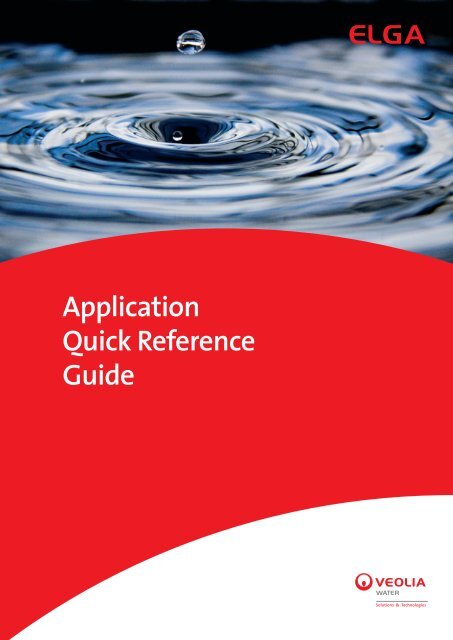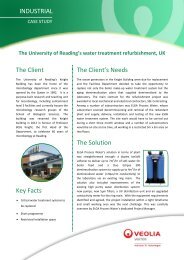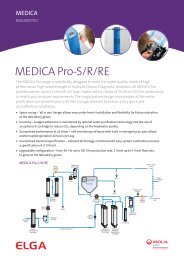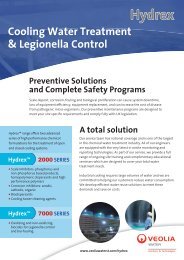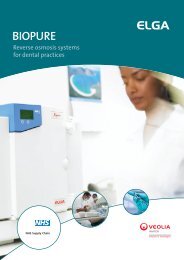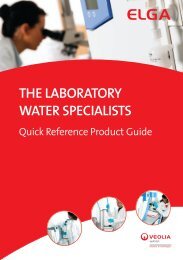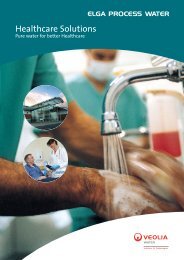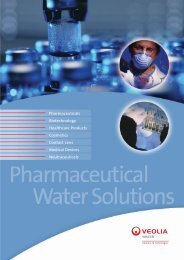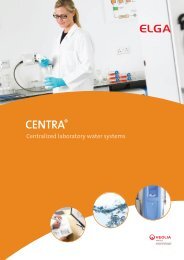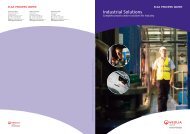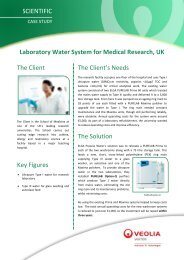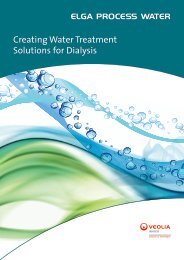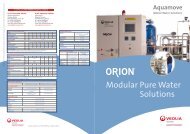Application Quick Reference Guide
Application Quick Reference Guide
Application Quick Reference Guide
Create successful ePaper yourself
Turn your PDF publications into a flip-book with our unique Google optimized e-Paper software.
<strong>Application</strong><br />
<strong>Quick</strong> <strong>Reference</strong><br />
<strong>Guide</strong>
Contents<br />
Aquariums ................................................................................................................................ 4<br />
Atomic Absorption Spectroscopy ............................................................................................. 4<br />
Autoclaves ............................................................................................................................... 5<br />
Biochemical Oxygen Demand. ................................................................................................. 5<br />
Capillary Electrophoresis. ........................................................................................................ 6<br />
Cell or Tissue Culture. ............................................................................................................. 6<br />
Chemical Oxygen Demand. ..................................................................................................... 7<br />
Colorimetric Testing. ................................................................................................................ 7<br />
Denaturing High Performance Liquid Chromatography ........................................................... 8<br />
Dissolution Testing. .................................................................................................................. 8<br />
DNA Microarrays. ..................................................................................................................... 9<br />
DNA Sequencing ..................................................................................................................... 9<br />
Electrochemistry .................................................................................................................... 10<br />
Electrophysiology ................................................................................................................... 10<br />
Endocrine - Disrupter Analysis ............................................................................................... 11<br />
Feed to Stills .......................................................................................................................... 11<br />
Feed to Ultrapure Water Systems .......................................................................................... 12<br />
Flame Atomic Absorption Spectrophotometry ........................................................................ 12<br />
Fuel Cells. .............................................................................................................................. 13<br />
Gas Chromatography and Gas Chromatography Mass Spectrophotrometry ......................... 13<br />
General Chemistry ...............................................................................................................<br />
Graphite Furnace Atomic Absortion Spectrophotrometry. ...................................................... 14<br />
Glassware Washing ............................................................................................................... 15<br />
Histology. ............................................................................................................................... 15<br />
High Performance Liquid Chromatography / Liquid Chromatography. ................................... 16<br />
Hydrogen Generators ............................................................................................................ 16<br />
Hydroponics ........................................................................................................................... 17<br />
Inductively coupled plasma atomic (or optical) emission spectrometry .................................. 17<br />
Inductively Coupled Plasma Mass Spectrometry ................................................................... 18<br />
Immunohistochemistry ........................................................................................................... 18<br />
In Vitro Fertilization. ............................................................................................................... 19<br />
Ion Chromatorography ........................................................................................................... 19<br />
Kjedahl Analysis..................................................................................................................... 20<br />
Liquid chromatography Mass Spectrometry ........................................................................... 20<br />
Lithography ............................................................................................................................ 21<br />
Matrix-Assisted Laser Desorption/Ionization .......................................................................... 21<br />
Microbiological Media. ........................................................................................................... 22<br />
Northern and Southern Blotting.............................................................................................. 22<br />
Particle Analyzers .................................................................................................................. 23<br />
Polymerase Chain Reaction .................................................................................................. 23<br />
pH Measurement ................................................................................................................... 24<br />
Protein Electrophoresis. ......................................................................................................... 24<br />
Sample Dilution and Reagent Preparation, ............................................................................ 25<br />
Solid Phase Extraction ........................................................................................................... 25<br />
Spectrophotometry . ............................................................................................................... 26<br />
2
Stability Tests......................................................................................................................... 26<br />
Steam Generation. ................................................................................................................. 27<br />
Surface Tension Experiments ................................................................................................ 27<br />
Titrators. ................................................................................................................................. 28<br />
Total Organic Carbon ............................................................................................................. 28<br />
Trace Metal Detection ............................................................................................................ 29<br />
Ultra High Performance Liquid Chromatography .................................................................. 29<br />
Volatile Oragnic Compounds . ............................................................................................... 30<br />
Water Analysis ....................................................................................................................... 30<br />
Western Blotting. .................................................................................................................... 31<br />
3
Aquariums<br />
An aquarium is a vivarium consisting of at least one<br />
transparent side in which water-dwelling plants or animals<br />
are kept. Providing water of appropriate physical and<br />
chemical quality is probably the most important factor for the<br />
care and maintenance of captive fish.<br />
The water quality and temperature should be optimized<br />
for the specific species of fish being used. Often purified<br />
water is used and nutrients etc. added. High purity is not<br />
needed but bacterial levels should be low. Type II pure<br />
water is sufficient.<br />
• Market : Life Science<br />
• Products : PURELAB ® Option-R<br />
Atomic Absorption Spectroscopy (AAS)<br />
AAS is a technique for the determination of the<br />
Total concentrations of specific elements in a sample.<br />
It is used for trace analysis at ppm (mg/l) or ppb (ug/l) levels<br />
Analysis by AAS requires the use of high purity reagents<br />
and solvents to ensure the accuracy and precision of<br />
measurements, as well as to avoid contamination during<br />
sample preparation and calibration. Type I ultrapure<br />
water is sufficient for high sensitivity and Type II pure<br />
water for general AAS.<br />
• Market : Analytical<br />
• Products : PURELAB Pulse, PURELAB flex,<br />
PURELAB Ultra, PURELAB Classic and PURELAB<br />
Option-Q<br />
4
Autoclaves<br />
Autoclaves are used in sterilizing media and instruments,<br />
and in the treatment and sterilization of waste, such as<br />
pathogenic hospital waste.<br />
Autoclaves utilize pressurized steam and superheated<br />
water. Only relatively small volumes of water are needed.<br />
High water purity is not essential. General laboratory<br />
grade Type II pure water would be satisfactory.<br />
• Market : Clinical healthcare, Life science, General<br />
laboratory<br />
• Products : BIOPURE 7/15 , 60/120, and 200-600,<br />
Biochemical or Biological Oxygen Demand<br />
(BOD)<br />
BOD provides a measure of the amount of biodegradable<br />
organic material present in wastewater, effluent and polluted<br />
waters. BOD measures the amount of dissolved oxygen<br />
consumed by bacteria while oxidizing these materials. It is a<br />
measure of the ecological impact that effluent water may<br />
have on the aqueous environment (river, lake, etc.).<br />
This test is often required in discharge permits, as it is a<br />
means of assessing the degree of water pollution. Water<br />
should have medium to low levels of total organic carbon<br />
(
Capillary Electrophoresis (CE)<br />
Capillary electrophoresis is a technique used to separate<br />
ionic species based on their size to charge ratio. It is used<br />
for small ions but has found a major role in proteomics.<br />
In CE, water is used to prepare the buffers, blanks,<br />
standards, and to rinse the capillary. It is important to use<br />
Type I ultrapure and Type II pure water that is low in<br />
organic and inorganic contaminants. Water free from bioactive<br />
species is needed for protein separations.<br />
Apyrogenic Type I ultrapure water is preferred.<br />
• Market : Analytical<br />
• Products: PURELAB Option-Q, PURELAB Ultra,<br />
PURELAB Classic, PURELAB Option-R and Pulse.<br />
Cell or Tissue Culture<br />
Cell culture is the process by which cells are grown under<br />
controlled conditions. Water is used in many steps of tissue<br />
or cell culture. It is the main component of buffers and<br />
media; it is used for the dissolution of additives and drugs,<br />
and for rinsing bioreactors, plastic ware and glassware.<br />
Water quality plays an important role in cell culture<br />
experimental outcomes. Apyrogenic Type I ultrapure<br />
water is essential. For larger-scale facilities<br />
pharmaceutical Water for Injection is used.<br />
• Market : Life science<br />
• Products: PURELAB Ultra and PURELAB flex<br />
6
Chemical Oxygen Demand (COD)<br />
The COD test is commonly used to indirectly measure the<br />
amount of organic compounds in water. Water is used in<br />
COD tests for blank preparation, sample dilutions and<br />
glassware rinsing.<br />
The recommended water purity is high with low levels of<br />
TOC (
Denaturing High Performance Liquid<br />
Chromatography (DHPLC)<br />
DHPLC uses reversed-phase HPLC, based on a solid phase<br />
which has differential affinity for single and double stranded<br />
DNA, to interrogate single nucleotide polymorphisms<br />
(SNPs). It is used in SNP genotyping, i.e. the measurement<br />
of genetic variations of SNPs between members of a<br />
species.<br />
Pyrogenic Type I ultrapure water is needed to avoid the<br />
effects of biologically active species such as endotoxins<br />
and nucleases.<br />
• Market : Life Science<br />
• Products: PURELAB Ultra, PURELAB Classic and<br />
PURELAB flex<br />
Dissolution Testing<br />
Dissolution testing is a critical formulation tool in the process<br />
of drug discovery.<br />
The purity of the water used in preparing the dissolution<br />
media is important since it is in direct contact with the<br />
drug product being tested. Impurities in the dissolution<br />
media may interfere with the drug itself or with some of<br />
the components of the dosage form. Type II pure water is<br />
sufficient.<br />
• Market : Clinical healthcare, General laboratory, Life<br />
science<br />
• Products: PURELAB Option-S,R and Pulse<br />
8
DNA Microarrays<br />
DNA microarray is a multiplex technology used in molecular<br />
biology. Purified water is used during the manufacturing<br />
process.<br />
In order to perform the DNA microarray experiment,<br />
enough DNA or RNA needs to be available. It is usually<br />
obtained via some kind of PCR-based DNA amplification<br />
technique, requiring nuclease free Type I ultrapure water.<br />
This step also requires buffers that must be prepared<br />
with apyrogenic Type I ultrapure water.<br />
• Market : Life science<br />
• Products : PURELAB Classic, PURELAB Ultra,<br />
PURELAB flex and PURELAB 7000<br />
DNA Sequencing<br />
DNA sequencing refers to sequencing methods for<br />
determining the order of the nucleotide bases in a molecule<br />
of DNA. The generation of DNA fragments, generally by a<br />
PCR-based technique is followed by the separation of the<br />
fragments by capillary or regular agarose gel<br />
electrophoresis.<br />
Apyrogenic Type I ultrapure water is needed<br />
• Market : Life science<br />
• Product : PURELAB Classic, PURELAB Ultra,<br />
PURELAB flex, PURELAB 7000 and CENTRA R<br />
9
Electrochemistry<br />
Electrochemistry covers the science of the interaction or<br />
interconversion of electrical and chemical phenomenon.<br />
It is vital that the water used produces minimal<br />
interference due to background contamination. High<br />
purity water is needed. For general work, general grade<br />
laboratory water is adequate, for trace work Type I<br />
ultrapure water is required.<br />
• Market : General laboratory, Analytical<br />
• Product : PURELAB Option-S/R, PURELAB Pulse,<br />
PURELAB flex, PURELAB 7000 and CENTRA R<br />
Electrophysiology<br />
Electrophysiology is the study of the electrical properties of<br />
biological cells and tissues. It involves measurements of<br />
voltage change or electric current on a wide variety of scales<br />
from single ion channel proteins to whole organs like the<br />
heart. When using electrophysiology techniques such as<br />
patch-clamp recording, all the solutions and equipment<br />
coming into contact with the cells must be sterile and of the<br />
highest purity available.<br />
Water is used for rinsing and to prepare the buffered<br />
solutions used to mimic the physiological conditions the cells<br />
were accustomed to (the cell culture media in the case of<br />
cultured cells). An extracellular solution (ECS) is used to<br />
bathe the cells, and an intracellular solution (ICS) is used to<br />
fill the pipettes.<br />
The ionic composition, pH and osmolarity of these<br />
solutions must be carefully controlled. Apyrogenetic Type<br />
I ultrapure water is needed.<br />
• Market : Life Science, General laboratory<br />
• Product : PURELAB Ultra, PURELAB classic,<br />
PURELAB flex ,PURELAB Option-S/R , PURELAB<br />
Pulse and PURELAB 7000<br />
10
Endocrine - Disrupter Analysis<br />
Endocrine disruptors are exogenous substances that act like<br />
hormones in the endocrine system and disrupt the<br />
physiologic function of endogenous hormones. They are<br />
sought in the environment and their effects also studied in<br />
the laboratory.<br />
All the test methods and trace analytical work require<br />
ultrapure water free of endocrine disrupters and other<br />
interferants.<br />
Apyrogenic Type I ultrapure water is used, according to<br />
the technique employed, for making buffers and<br />
standards for the production of the cell culture media.<br />
• Market : Life science, General Laboratory<br />
• Products: PURELAB Ultra, PURELAB Classic and<br />
PURELAB flex<br />
Feed to stills<br />
Stills produce purified water by evaporating and then<br />
condensing the feed water. Extra stages are required to<br />
minimise carry-over and collection of volatiles.<br />
Partially purified feed water is needed to operate viably.<br />
low ionic feed water for a still reduces excessive build-up<br />
of deposits which would require frequent cleaning and<br />
minimises carry over. Reverse osmosis permeate or<br />
deionised water is often used. Type III RO water is<br />
suffiecient.<br />
• Market : General Laboratory<br />
• Products: PURELAB Prima, PURELAB Option S and<br />
PURELAB 3000<br />
11
Feed to Ultrapure Water Systems<br />
Type I ultrapure water is widely used in laboratories. It is<br />
often conveniently prepared in two stages: a source of prepurified<br />
water followed by a “polisher” to achieve the highest<br />
purity water.<br />
The pre-purified water is produced by reverse osmosis<br />
with possibly, ion-exchange or electrodeionisation and<br />
stored in a reservoir before polishing. The quality of this<br />
pre- treated water affects the performance of the system<br />
and cartridge life. Type III RO or Type II pure water is<br />
sufficient.<br />
• Market : General laboratory<br />
• Product : PURELAB Prima, PURELAB Option-S/R,<br />
PURELAB Pulse, PURELAB 3000 / 7000 and<br />
CENTRA R<br />
Flame Atomic Absorption Spectroscopy<br />
(FAAS)<br />
FAAS is a widely used technique for determining metals and<br />
metalloids in solution at ppb or ppm levels.Metal ions are<br />
converted to the atomic state by nebulisation into a hightemperature<br />
flame. Light of the appropriate wavelength is<br />
shone through the flame and the amount of light absorbed<br />
measured against a standard curve.<br />
Analysis by AA requires the use of analytical grade<br />
reagents and solvents to ensure the accuracy and<br />
precision of measurements. Type II pure water with a<br />
resistivity greater than 5 Mohm.cm is usually suitable.<br />
• Market : Analytical, General laboratory<br />
• Product : PURELAB Option-S/R , PURELAB Pulse,<br />
PURELAB flex, PURELAB 3000 / 7000 and CENTRA<br />
R<br />
12
Fuel Cells<br />
Fuel cells are electrochemical cells that convert chemical<br />
energy from the reaction of a fuel (usually hydrogen) with<br />
an oxidising agent (usually oxygen from air) directly into<br />
electrical energy. Various combinations of fuel and oxidant<br />
are possible.<br />
Where water is used it must be sufficiently pure to avoid<br />
contaminating the electrodes etc. Type II pure water is<br />
usually satisfactory.<br />
• Market : Analytical<br />
• Product : PURELAB Option R,S and Pulse<br />
Gas Chromatography (GC) and Gas<br />
Chromatography – Mass Spectrophotrometry<br />
(GC-MS)<br />
GC and GC-MS are the most sensitive and widely used<br />
techniques for the separation and determination of the<br />
components of mixtures of volatile or semi-volatile<br />
compounds.<br />
Samples are volatilized and separated on a column. The<br />
technique is especially powerful when a mass spectrometer<br />
is used as a detector as individual components can then be<br />
characterized and identified directly.<br />
Type I ultrapure water is used mainly in sample<br />
preparation. Low TOC (typically
General chemistry<br />
General scientific work such as in schools and general<br />
industry.<br />
Requires Type II pure water to get reliable results. Most<br />
applications are at ppm levels or higher and water purity<br />
requirements are not high. Reverse osmosis alone is not<br />
adequate but Type II general laboratory grade water with<br />
resistivity >1 Mohm.cm and TOC < 100 ppb is suitable.<br />
• Market : General laboratory<br />
• Product : PURELAB Option-S/R, PURELAB Pulse,<br />
PURELAB flex, PURELAB 3000 / 7000 and CENTRA<br />
R<br />
Graphite furnace atomic absorption<br />
spectrophotrometry (GF-AAS)<br />
GF-AAS is a variant of AAS which uses a small carbon tube<br />
rather than a flame to atomize the sample. It is a very<br />
sensitive method suitable for the measurement of ultra-trace<br />
levels of elements. The detection limits for many elements<br />
are well below 1ppb.<br />
Water is used to prepare blanks, standards, sample<br />
preparation and needs to be extremely low in relevant<br />
impurities. Type I ultrapure water is required.<br />
• Market : General laboratory<br />
• Product : PURELAB Option-S/R, PURELAB Pulse,<br />
PURELAB flex, PURELAB 3000 / 7000 and CENTRA<br />
R<br />
14
Glassware Washing<br />
Glassware washing is a universal laboratory activity and a<br />
major use for purified water, principally for the final rinse<br />
stages to avoid the staining and build-up of deposits from<br />
tap water. The purity of water required depends on the<br />
applications of the items being washed.<br />
General purpose Type II pure water is usually<br />
suitable.Water contaminants can interfere with<br />
detergents. Therefore, softened or purified water is also<br />
usually recommended for the washing step of the<br />
process.<br />
• Market : Analytical, General laboratory, Life science<br />
• Product : PURELAB Option-S/R, PURELAB Pulse,<br />
PURELAB 3000 / 7000 and CENTRA R<br />
Histology<br />
Histology is the study of the microscopic anatomy of cells<br />
and tissues of plants and animals, performed by examining<br />
a thin slice (section) of tissue under a light microscope or<br />
electron microscope. Histopathology, the microscopic study<br />
of diseased tissue, is an important tool in the diagnosis of<br />
cancer and other diseases.<br />
General grade Type II pure water, low in bacteria and<br />
particles is suitable.<br />
• Market: Analytical, Life Science, General Laboratory<br />
• Product : PURELAB Option-S/R, PURELAB Pulse,<br />
PURELAB flex, PURELAB 3000 / 7000 and CENTRA<br />
R,<br />
15
High Performance Liquid Chromatography<br />
(HPLC) or simply Liquid Chromatography<br />
(LC)<br />
HPLC can separate a mixture of compounds and is used in<br />
biochemistry and analytical chemistry to identify, quantify<br />
and purify the individual components of the mixture. It is one<br />
of the most powerful tools in analytical chemistry. It has<br />
become a very common laboratory instrument. With suitable<br />
choice of methodology, HPLC has the ability to separate,<br />
identify, and quantiatify most compounds present in any<br />
sample that can be dissolved in a liquid. Today, compounds<br />
in trace concentrations as low as parts per trillion may be<br />
identified with the appropriate detector.<br />
Type I ultrapure water with typical TOC less than 5 ppb is<br />
needed for the more demanding applications.<br />
• Market: Analytical<br />
• Product : PURELAB Classic, PURELAB flex,<br />
PURELAB Ultra and CENTRA R<br />
Hydrogen Generators<br />
Hydrogen generators use electrolytic dissociation of water to<br />
generate a continuous supply of high purity hydrogen<br />
suitable to feed a range of analytical applications including<br />
mass spectrometry and GC.<br />
Type II pure water (distilled or deionized quality) is<br />
needed as water purity is important for optimal<br />
performance and to minimise maintenance.<br />
• Market : Analytical<br />
• Products: PURELAB Option R/S, PURELAB Pulse<br />
and PURELAB flex<br />
16
Hydroponics<br />
Cultivation of plants in nutrient solution rather than in soil.<br />
Terrestrial plants may be grown with their roots in the<br />
mineral nutrient solution only or in an inert medium.<br />
Nutrients solutions are prepared using purified water<br />
which can be a general laboratory grade. Type II pure<br />
water is sufficient.<br />
• Market : Life science<br />
• Products: PURELAB Option S,R and PURELAB<br />
Pulse<br />
Inductively coupled plasma atomic (or<br />
optical) emission spectrometry (ICP-AES/<br />
ICP-OES)<br />
ICP-AES or ICP-OES is an analytical technique used for<br />
multi element analysis. It has a wide linear range and is<br />
used for concentrations from ppb to g/l.<br />
Quality sub-ppb levels of metallic impurities are important<br />
in the Type I ultrapure water used to prepare blanks,<br />
standards etc of trace metals.<br />
• Market : Analytical<br />
• Product : PURELAB Option-Q, PURELAB flex,<br />
PURELAB Ultra and PURELAB classic<br />
17
Inductively Coupled Plasma Mass<br />
Spectrometry (ICP-MS)<br />
ICP-MS uses a high temperature source and a mass<br />
spectrometer to provide the most sensitive method for<br />
general analysis of elements in solution with detection limits<br />
below 1 ppt for many elements. Clean room conditions are<br />
preferred.<br />
Water is extensively used for sample preparation,<br />
standards and blanks. Extremely Type I ultrapure water<br />
free from elemental impurities is essential to avoid<br />
contamination. Low levels of organics are also desirable.<br />
• Market : Analytical<br />
• Product : PURELAB Option-Q, PURELAB flex,<br />
PURELAB Ultra and PURELAB classic<br />
Immunohistochemistry<br />
Immunohistology refers to the process of localizing antigens<br />
in cells of a tissue section exploiting the principle of<br />
antibodies binding specifically to antigens in biological<br />
tissues. Water is ubiquitous in histology laboratories. It is<br />
used in water baths, floatation baths, and in most of the<br />
automated instruments present in the laboratory.<br />
Poor quality water may generate hard deposits or<br />
bacterial bio films. Apyrogenic Type I ultrapure water is<br />
needed if it comes into contact with the materials under<br />
test.<br />
• Market : Life science<br />
• Product :PURELAB flex, PURELAB Classic,<br />
PURELAB Ultra, PURELAB 3000 / 7000 and<br />
CENTRA R<br />
18
In Vitro Fertilization (IVF)<br />
IVF is a laboratory procedure in which typically sperm are<br />
placed with an unfertilized egg in a Petri dish to achieve<br />
fertilization. The success of the procedure depends critically<br />
on the absence of bio-active contaminants such as<br />
endotoxins.<br />
Apyrogenic Type I ultrapure water is used.<br />
• Market : Life science<br />
• Product :PURELAB flex, PURELAB Classic and<br />
PURELAB Ultra<br />
Ion Chromatography (IC)<br />
IC is a chromatographic technique that allows the separation<br />
of ions and polar molecules based on their interaction with a<br />
column of ion-exchange media.. It can be used for almost<br />
any kind of charged molecule including large proteins, small<br />
nucleotides and amino acids. It is very widely used for<br />
determining inorganic and organic cations and especially<br />
anions. With pre-concentration low-ppt concentrations may<br />
be measured.<br />
Type I ultrapure water is needed for blanks, standards, to<br />
prepare samples and for eluents.<br />
• Market: Life Sciences<br />
• Product: PURELAB Ultra, PURELAB classic,<br />
PURELAB flex, PURELAB 3000 / 7000 and CENTRA<br />
R<br />
19
Kjeldahl Analysis<br />
The method measures the total nitrogen in the forms of<br />
organically-bound nitrogen, ammonia and ammonium. The<br />
substance is decomposed with sulfuric acid to convert the<br />
nitrogen to ammonium ions which are subsequently<br />
released as ammonia absorbed and titrated. It is used to<br />
determine protein levels in food and nitrogen in soils,<br />
effluent and wastewater.<br />
Water is used in the preparation of the reagents,<br />
standards and samples, and for rinsing the glassware<br />
and the apparatus. Water may also be used to generate<br />
steam for the distillation step of the analysis and for<br />
cooling (in condensers, etc.). General laboratory grade<br />
Type II pure water is suitable.<br />
• Market: Analytical<br />
• Product : PURELAB Option S,R and PURELAB Pulse<br />
Liquid Chromatography Mass Spectrometry<br />
(LC-MS)<br />
LC-MS is an increasingly widespread analytical technique<br />
that combines the physical separation capabilities of liquid<br />
chromatography with the mass analysis and characterization<br />
capabilities of mass spectrometry. LC-MS is a powerful<br />
technique with very high sensitivity and at its best when<br />
analysing complex mixtures.<br />
Water contaminants may impact on both the<br />
chromatography and the mass spectrometry. Type I<br />
ultrapure water with a TOC of less than 5 ppb is<br />
recommended.<br />
• Market : Analytical<br />
• Product : PURELAB Option-Q, PURELAB flex,<br />
PURELAB Ultra, and PURELAB classic<br />
20
Lithography<br />
Immersion lithography is a photolithography resolution<br />
enhancement technique that replaces the usual air gap<br />
between the final lens and the wafer surface with a liquid<br />
medium that has a refractive index greater than one. The<br />
resolution is increased by a factor equal to the refractive<br />
index of the liquid.<br />
Current immersion lithography tools use highly purified<br />
water for this liquid, achieving feature sizes below 45<br />
nanometers. Particle-free Type I ultrapure water is<br />
recommended.<br />
• Market : General laboratory<br />
• Product : PURELAB Ultra and PURELAB flex<br />
Matrix-Assisted Laser Desorption/<br />
Ionization (MALDI)<br />
Matrix-assisted laser desorption/ionization (MALDI) is a soft<br />
ionization technique used in mass spectrometry, allowing<br />
the analysis of bio molecules (biopolymers such as proteins,<br />
peptides and sugars) and large organic molecules, which<br />
tend to be fragile and fragment when ionized by more<br />
conventional ionization methods.<br />
Although MALDI is more tolerant to contamination than<br />
other ionization methods, it is important to use reagents<br />
(e.g., matrix) and solvents of the highest purity so as to<br />
avoid making the analysis of the mass spectra more<br />
challenging than it already is. Type I ultrapure water with<br />
TOC < 5 ppb is recommended.<br />
• Market : Life Science<br />
• Product :PURELAB flex, PURELAB Classic and<br />
PURELAB Ultra<br />
21
Microbiological Media<br />
Growth media are routinely required in a wide range of<br />
microbiological, hospital and bioscience laboratories where<br />
cells are cultured.<br />
Water used for the preparation of growth media is usually<br />
of general laboratory grade as high inorganic and organic<br />
purity is not required. Media are generally autoclaved<br />
before use. For further studies on microorganisms,<br />
including genetics, PCR-based techniques, microarrays,<br />
protein analysis or others, please refer to the<br />
corresponding sections. Type I ultrapure water is<br />
recommended.<br />
• Market : Life science, General laboratory<br />
• Product : PURELAB Option-Q, PURELAB flex,<br />
PURELAB Ultra, PURELAB classic and CENTRA R<br />
Northern & Southern Blotting<br />
The Southern blot is a method routinely used in molecular<br />
biology for detection of a specific DNA sequence in DNA<br />
samples. The Northern blot is a technique used to study<br />
gene expression by detection of RNA in a sample.<br />
Apyrogenic Type I ultrapure water is used for many steps<br />
of blotting: sample, buffer, gels and rinsing solutions<br />
preparation. Prior to blotting itself, either for Southern or<br />
Northern blotting, the sample preparation requires the<br />
highest purity of water to protect the raw material DNA or<br />
RNA.<br />
• Market : Life science<br />
• Product : PURELAB Option-Q, PURELAB flex,<br />
PURELAB Ultra and CENTRA R<br />
22
Particle Analyzers<br />
Particle analysis is used in many applications ranging from<br />
sub-micron measurements in water for micro-electronics<br />
The absence of contaminating particles in the water is<br />
key. Water purity itself is not usually critical. 0.2 um<br />
filtration is often adequate but this can be extended to<br />
0.05um or lower. Type II pure water is recommended for<br />
general sensitivity and Type I ultrapure water should be<br />
used for more critical sensitivity.<br />
• Market : Analytical<br />
• Product : PURELAB Option R, PURELAB Pulse,<br />
PURELAB flex, PURELAB Ultra, PURELAB Classic<br />
and PURELAB Option-Q<br />
Polymerase Chain Reaction (PCR)<br />
PCR is a technique in molecular biology to amplify a single<br />
or few copies of a piece of DNA by several orders of<br />
magnitude, generating thousands to millions of copies of a<br />
particular DNA sequence.<br />
PCR and related PCR-based techniques, including<br />
quantitative PCR and reverse transcriptase PCR, require<br />
nuclease-free and endotoxin-free water to avoid the<br />
degradation of the nucleic acid. Water should also be<br />
free of specific ions, organics and bacteria. Apyrogenic<br />
Type I ultrapure water is essential.<br />
• Market: Life Sciences<br />
• Product : PURELAB Option-Q, PURELAB flex,<br />
PURELAB Ultra, PURELAB classic and CENTRA R<br />
23
pH Measurement<br />
pH is a measure of the acidity or basicity of a solution. It is<br />
quick and easy to determine and is important in many<br />
applications.<br />
the water used to prepare pH standards should be<br />
devoid of significant concentrations of acids or bases and<br />
free of other substances that can modify the pH of the<br />
solutions. General grade Type II pure water is adequate.<br />
• Market : General laboratory<br />
• Product : PURELAB Option R,S and PURELAB Pulse<br />
Protein Electrophoresis<br />
Protein electrophoresis enables the separation of mixtures<br />
of proteins by means of gel electrophoresis, mainly in blood<br />
serum.<br />
.<br />
Apyrogenic type I ultrapure water is needed to avoid<br />
contamination by bacteria, nucleases, proteases and<br />
endotoxins. High concentrations of ions may alter the<br />
ionic strength of electrophoresis solutions.<br />
• Market : Life science<br />
• Product : PURELAB Ultra, PURELAB Classic and<br />
PURELAB flex<br />
24
Sample dilution and reagent preparation<br />
The water required for diluting samples, blanks, reagents<br />
and standards must be of sufficient purity that subsequent<br />
analyses are not affected.<br />
The water required for diluting samples, blanks, reagents<br />
and standards must be of sufficient purity that<br />
subsequent analyses are not affected. These can range<br />
from ppb to ppt levels. Type II pure water is<br />
recommended.<br />
• Market : General laboratory<br />
• Product : PURELAB Option-S,R, PURELAB Pulse,<br />
PURELAB flex, PURELAB 3000 / 7000 and CENTRA<br />
R<br />
Solid Phase Extraction (SPE)<br />
SPE is a semi-automated separation and concentration<br />
process by which compounds that are dissolved or<br />
suspended in a liquid mixture are taken up on a solid<br />
substrate and subsequently eluted before analysis.<br />
For trace analysis water of the highest organic purity is<br />
needed to prepare blanks and standards and to rinse the<br />
solid phase. Type I ultrapure water with a TOC of less<br />
than 5 ppb is needed.<br />
• Market : General laboratory<br />
• Product : PURELAB flex, PURELAB Classic,<br />
PURELAB Ultra and CENTRA R<br />
25
Spectrophotometry<br />
Water is used to prepare samples, to prepare standards and<br />
as a blank and to rinse the cuvettes.<br />
Water purity is dependent on the sensitivity of the<br />
methods being used. General laboratory grade Type II<br />
pure water is generally satisfactory.<br />
• Market : Analytical<br />
• Product : PURELAB Ultra, PURELAB classic,<br />
PURELAB Option-Q, PURELAB flex, PURELAB 3000<br />
/ 7000 and CENTRA R<br />
Stability Tests<br />
Chambers with controlled humidity require a source of<br />
purified water. Humidification of chamber air is achieved by<br />
water vapour injection. Some systems have a built-in water<br />
purification system, including a UV lamp to reduce bacterial<br />
contamination. The water is then recycled.<br />
General laboratory grade Type II pure water is adequate.<br />
• Market : General laboratory<br />
• Product : PURELAB Option-S,R , PURELAB Pulse,<br />
PURELAB flex, PURELAB 3000 / 7000 and CENTRA<br />
R<br />
26
Steam generation<br />
A steam generator is a device used to boil water to create<br />
steam.<br />
In the same way as stills, steam generators benefit from<br />
pre-treatment of the water supply to avoid build up,<br />
precipitation or contamination in order to reduce<br />
maintenance, improve performance and enhance<br />
hygiene level. General laboratory grade Type II pure<br />
water is adequate.<br />
• Market : Life science<br />
• Product : PURELAB Option-S,R , PURELAB Pulse,<br />
PURELAB flex, PURELAB 3000 / 7000 and CENTRA<br />
R<br />
Surface Tension Experiments<br />
Surface tension is a property of the surface of a liquid<br />
caused by cohesion of like molecules, which is responsible<br />
for much of the behaviours of liquids.<br />
Surface tension is strongly affected by water purity and<br />
Type I ultrapure water is often needed for these<br />
experiments<br />
• Market : Analytical<br />
• Product : PURELAB flex, PURELAB Ultra, PURELAB<br />
Option-Q and PURELAB Classic<br />
27
Titrators<br />
Titration is a common laboratory method of quantitative<br />
chemical analysis for specific components at medium to high<br />
concentrations. Water is used for the preparation of<br />
standard solutions and titration solutions (such as buffers,<br />
reagents). It is also used for washing the electrodes and the<br />
vessels in which the reaction occurs.<br />
Type II pure water is recommended<br />
• Market : General laboratory, Life science, Analytical<br />
• Product : PURELAB Option R,S and PURELAB Pulse<br />
Total Organic Carbon (TOC)<br />
TOC is the amount of carbon bound in organic compounds,<br />
for example, in an aqueous solution. It is often used as a<br />
non-specific indicator of the level of organic contamination in<br />
water or cleanliness of pharmaceutical manufacturing<br />
equipment.<br />
Water is used to prepare the standards necessary for the<br />
instrument calibration, to run the blanks, and in to clean<br />
up or rinse the instrument. In order to optimize the<br />
performances of TOC analysis, in particular in the<br />
concentration range below 1 ppm, it is important to have<br />
water with very low TOC (typically
Trace Metal Detection<br />
Trace metal detection may be carried out by a variety of<br />
methods. Due to its extremely high sensitivity and specificity<br />
ICP-MS has become very popular. ICP- AES is still widely<br />
used for multi-element analysis and AAS provides a<br />
cheaper alternative when less elements are being<br />
determined. Spectrophotometric and electrochemical<br />
detection have advantages in specific cases.<br />
Water purity requirements depend on the sensitivity<br />
needed. Type I ultrapure water is generally<br />
recommended.<br />
• Market : Analytical<br />
• Product : PURELAB Ultra, PURELAB classic, PURELAB<br />
3000 / 7000 and CENTRA R<br />
Ultra High Performance Liquid<br />
Chromatography (UHPLC)<br />
UHPLC is a variant of HPLC using smaller particles to<br />
enhance chromatographic performance. Higher pressures<br />
are needed. The water contaminants that affect HPLC also<br />
impact UHPLC, but due to greater sensitivity, this can be to<br />
a more significant extent in some cases. Also, columns filled<br />
with very small particles are more susceptible to premature<br />
plugging by particulates compared to their HPLC column<br />
counterparts with larger particles.<br />
Type I ultrapure water with a TOC of less than 5ppb is<br />
essential.<br />
• Market : Analytical<br />
• Product : PURELAB Option-Q, PURELAB flex,<br />
PURELAB Ultra and PURELAB Classic<br />
29
Volatile Organic Compounds (VOC)<br />
Determination<br />
VOC are determined by GC or GC-MS after<br />
preconcentration using purge and trap.<br />
Water may be used to rinse the sample containers, in the<br />
various sample preparation steps, as well as in the<br />
preparation of standards and blanks for the analysis.<br />
Type I ultrapure water with very high sensitivity is<br />
possible and with typical TOC below 5ppb is needed.<br />
• Market : General laboratory<br />
• Product : PURELAB Option-Q, PURELAB flex,<br />
PURELAB Ultra, PURELAB Classic and CENTRA R<br />
Water analysis<br />
Water analysis is the determination of the physical,<br />
chemical, and biological characteristics of water, typically for<br />
potable use. Such analysis usually involves four kinds of<br />
examination: bacterial, chemical, microscopic, and physical.<br />
Type I ultrapure or Type II pure water can be used for<br />
reagents, blanks etc. should have impurities at low ppb<br />
levels - a resistivity greater than 5 Mohm.cm.<br />
• Market : General laboratory, Analytical, Life science<br />
• Product : PURELAB Option-S/R, PURELAB Pulse,<br />
PURELAB flex, PURELAB 3000 / 7000 and CENTRA R<br />
30
Western Blotting<br />
The western blot is an analytical technique used to detect<br />
specific proteins in a given sample of tissue homogenate or<br />
extract. It uses gel electrophoresis to separate native or<br />
denatured proteins by the length of the polypeptide<br />
(denaturing conditions) or by the 3-D structure of the protein<br />
(native/ non-denaturing conditions).<br />
In Western blotting, water is used to prepare the transfer<br />
buffer, buffers used to prepare the blocking solution,<br />
primary and secondary antibodies, and the wash<br />
solutions. It is critical to use water that is free of<br />
contaminants that are biologically active and could<br />
interfere. Apyrogenic type I ultrapure water is essential.<br />
• Market : General laboratory, Life science<br />
• Product : PURELAB flex, PURELAB Ultra, PURELAB<br />
Classic and PURELAB Option-Q<br />
31
ELGA® is the global laboratory water brand name of Veolia Water<br />
Solutions and Technologies. The information contained in this<br />
document is the property of VWS (UK) Ltd, trading as ELGA LabWater,<br />
and is supplied without liability for errors or omissions. © VWS (UK)<br />
Ltd. 2011 – All rights reserved. ELGA®, PURELAB®, MEDICA® and<br />
CENTRA® are registered trademarks of VWS (UK) Ltd.<br />
About ELGA<br />
ELGA LabWater manufactures supplies and services laboratory,<br />
healthcare and clinical water purification systems. ELGA offices and<br />
distributors are located in more than 60 countries worldwide. ELGA is<br />
the global laboratory water brand name of Veolia Water Solutions &<br />
Technologies.<br />
ELGA is an integral part of Veolia Water Solutions and Technologies.<br />
Veolia Water Solutions & Technologies (VWS), subsidiary of Veolia<br />
Water, is a leading design & build company and a specialized provider of<br />
technological solutions in water treatment. With over 9,500 employees<br />
in 57 countries, Veolia Water Solutions & Technologies recorded revenue<br />
of €2.15 billion Euros in 2010.<br />
For a free copy of the Pure<br />
Labwater <strong>Guide</strong> please visit:<br />
www.elgalabwater.com/pwg<br />
Veolia Water, the water division of Veolia Environnement, is the world<br />
leader in water and wastewater services. Specialized in outsourcing<br />
services for municipal authorities, as well as industrial and service<br />
companies, Veolia Water provides water service to 95 million people and<br />
wastewater service to 66 million. With 96,260 employees in 66 countries,<br />
its 2010 revenue amounted to €12.1 billion.<br />
Email: info@elgalabwater.com<br />
Web: www.elgalabwater.com<br />
ELGA The LabWater Specialists


